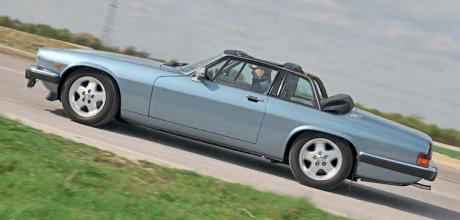The 1980s – Jaguar XJ-S Cabriolet

Due to such luminaries as the XK120, E-Type and XJ6 as well as the five Le Mans victories, it’s understandable why many consider the 1950s and 1960s to be Jaguar’s golden era. Yet in my view the company’s best decade is a completely different time for several reasons: the 1980s.
Although still a highly controversial period in the company’s long history due to the chronic unreliability which had long dogged the company’s reputation, some of my favourite models stem from this time, including the XJ Series 3. The Pininfarina refresh of the Series 2 in the late Seventies resulted in what’s considered by many to be one of the best looking and elegant saloons ever made.
WHILE THOSE OTHER SUCCESSES BELONGED TO MY DAD’S GENERATION, THIS ONE WAS MINE
Then there’s the XJ-S Cabriolet from 1983 (pictured). Although some reckon the targa top makes the car less aesthetically pleasing or as easy to use as the later full convertible, I think it’s a handsome adaptation especially considering how little time and money the then cash-strapped company was able to spend on its development. The comparatively rare model also had a small but significant role in Jaguar’s survival and then revival. As its first open car since 1974 when production of the E-Type came to an end, it added some much needed glamour to the company’s increasingly staid range.
Due to those aforementioned financial doldrums Jaguar was facing in the early part of the decade, it was a brave yet calculated decision for the company’s then chairman, the always charismatic and forward thinking (Sir) John Egan, to support TomWalkinshaw Racing’s bid to enter the XJ-S 5.3 into the 1982 European Touring Car Championship.
“I had realised that there had to be a place for racing in the scheme of things,” wrote Egan in his 2015 autobiography, Saving Jaguar. “Our heritage here was very powerful.” He went on to conclude, that “racing had given the old Jaguar designers the capability to create products that were better than those of their competitors.”
By being fast, competitive and entertaining, the early Eighties remains my favourite era of the ETCC. It helped that TWR was able to transform the XJ-S into a surprisingly fast and successful racing car, culminating in Walkinshaw himself winning the 1984 crown. More importantly, the project eventually led to TWR and Jaguar entering endurance racing during one of its most competitive periods, the famous Group C.
The sight of the white, purple and gold Jaguars hurtling wheel-to- wheel down Le Mans’ long Mulsanne Straight with a Porsche 962 is for me more exciting than any of the company’s five victories three decades earlier. With the 24-hour race barely covered in the UK at the time, I remember the excitement of reading about Jaguar’s 1988 victory in my father’s copy of Motor Sport. While those other successes belonged to my dad’s generation, this one was mine.
Perhaps more importantly, that 1988 victory lay the foundations for Jaguar’s R range. Although it started relatively small with the limited edition XJR-S Le Mans Celebration from 1988, its instant success meant it later became a production model. In terms of its looks, performance and racing-inspired image, the XJR-S 6.0-litre remains one of my favourite Jaguars. Onamore commercial level, almost every subsequent saloon and sports car has had an R variant making it an important and fundamental part of Jaguar’s image and success over the past 35 years.
If you add in the 1986 introduction of the XJ40, the XJ220 prototype from 1988 and finally Ford buying Jaguar in 1989, whether or not you like the cars that came from this period, the 1980s remains one of the company’s most successful, fascinating and diverse decades.

